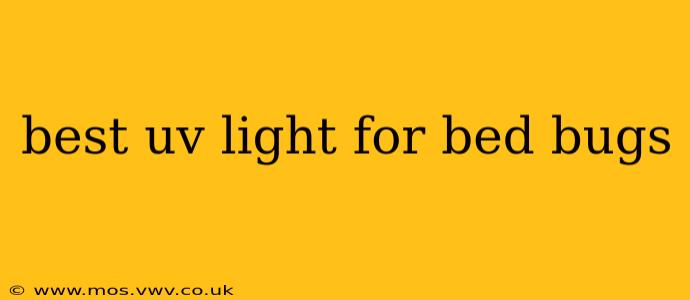Bed bugs are tiny, nocturnal insects that feed on human blood, causing itchy welts and sleepless nights. Detecting them early is crucial for effective treatment. While a UV light won't kill bed bugs, it can significantly aid in their detection. This guide will help you understand how UV lights assist in bed bug identification and which types are best suited for this purpose.
What is a UV Light, and How Does it Help Find Bed Bugs?
UV (ultraviolet) lights emit light beyond the visible spectrum. While bed bugs themselves don't fluoresce under UV light, their excrement often does. Bed bug feces are typically dark brown or black spots, and when exposed to UV light, they can sometimes appear to glow, making them easier to spot in hard-to-reach areas like mattress seams and cracks in furniture. This is especially useful in identifying infestations before a full-blown problem develops. It's important to note that not all bed bug feces will fluoresce, and this method is best used as a supplementary detection tool.
What Type of UV Light is Best for Bed Bug Detection?
The ideal UV light for bed bug detection is a high-intensity, handheld UV-A blacklight. Here's why:
- UV-A vs. UV-B/C: UV-A light is safer than UV-B and UV-C light and is sufficient for this purpose. UV-B and UV-C are more damaging to human skin and eyes.
- Handheld: A handheld device offers greater flexibility and maneuverability, allowing you to examine various areas thoroughly.
- High-Intensity: A brighter light will increase the chances of detecting any fluorescent excrement. Look for lights with a high lumen output.
While larger, professional-grade UV lights exist, they are usually unnecessary for home use. A portable and affordable handheld model is typically sufficient for detecting bed bug infestations in your home.
How to Use a UV Light to Find Bed Bugs
- Darken the room: Turn off all other lights to maximize the effectiveness of the UV light.
- Systematic Inspection: Carefully examine all suspected areas, including mattress seams, box springs, bed frames, headboards, baseboards, and furniture crevices. Pay close attention to areas where bed bugs like to hide.
- Interpret Findings: If you see glowing spots, it might indicate the presence of bed bug feces. Remember that the absence of glowing spots doesn't guarantee the absence of bed bugs. Other signs of infestation should be considered.
What are other signs of bed bugs besides glowing feces under UV light?
This is a frequently asked question, and it's crucial to remember that UV light is just one tool. Other indicators of a bed bug infestation include:
- Live bed bugs: Small, reddish-brown insects (about the size of an apple seed) found in mattresses, bedding, or furniture.
- Bed bug eggs: Tiny, pearly-white eggs usually found in clusters.
- Bed bug shed skins: These are the exoskeletons left behind after a bed bug molts.
- Dark spots (bed bug feces): These can be seen regardless of whether or not they fluoresce under a UV light.
- A musty odor: Bed bugs produce a distinctive, unpleasant odor.
Are there any drawbacks to using a UV light for bed bug detection?
- Not foolproof: Not all bed bug feces fluoresce under UV light. This method alone is not a conclusive test for infestation.
- False positives: Other substances may fluoresce under UV light, leading to misidentification.
- Doesn't kill bed bugs: A UV light only aids in detection; it does not eliminate the infestation.
What should I do if I find bed bugs using a UV light?
If you suspect a bed bug infestation, even with only indirect evidence like fluorescing feces, it's important to take immediate action. Contact a pest control professional for effective treatment and prevention strategies. Attempting to handle a large infestation yourself is often ineffective and can make the problem worse.
Remember, while a UV light can be a valuable tool in bed bug detection, it's just one piece of the puzzle. Combine it with a thorough visual inspection and, if necessary, professional pest control services for the best results. Early detection is key to effective bed bug control.
